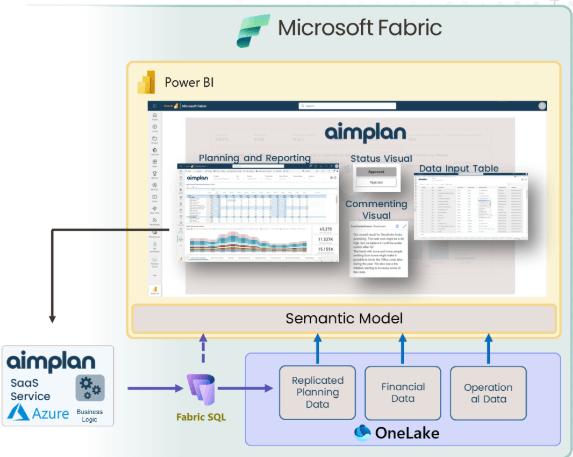Webinar takeaways: Becoming more Data-Driven in Finance
7 November 2025- Data is key to making evidence-based decisions.
- Finance has the opportunity to lead the data transformation journey.
- Lakehouse architecture offers a future-proof foundation for managing and organizing all types of data.
- Microsoft Fabric provides a scalable, unified, and modern data platform for the entire analytics lifecycle.
- Aimplan brings financial planning and analytics together within the Microsoft ecosystem bridging the gap between insight and action.
- By combining strategy, architecture, and technology, finance teams can truly evolve from reporting on the past to shaping the future.
Why becoming data-driven matters
Led by experts Maarten Lauwaert, Ivo Merchiers, and Evert Augustyns, the webinar explored how finance teams can evolve from reporting the past to building the future through modern data architecture, unified analytics, and integrated planning tools.
Today’s finance professionals must go beyond compliance to become strategic business partners, making evidence-based decisions grounded in accurate, reliable, and timely data.
Our experts outlined key reasons to adopt a data-driven mindset:
- Integrate financial, operational, HR, and sales data to understand performance drivers.
- Move from descriptive to predictive and prescriptive analytics to improve forecasting.
- Boost efficiency in closing, consolidation, and reporting.
- Attract and retain talent with a modern, data-centric environment.
- Empower finance to lead strategic, data-aligned decisions organization-wide.
Becoming data-driven starts with a clear data strategy that unites people, processes, and technology, the foundation of any modern analytics journey.
Overcoming key challenges
Over 70 webinar participants from various industries identified their biggest obstacles in becoming data-driven. While several challenges emerged, data quality and technology-related issues stood out as the most frequently cited barriers.
Common challenges included:
- Lack of a clear data strategy or vision
- Poor data quality or data silos
- Limited data literacy across teams
- Legacy systems and fragmented technologies
- Difficulty proving ROI from data initiatives
Our experts emphasized that technology alone isn’t the answer. Success depends on combining sound data governance, collaboration between business and technical teams, and a future-proof data roadmap.

Microsoft Fabric: unifying the data experience
Microsoft Fabric is Microsoft’s new end-to-end data analytics platform, designed around the lakehouse concept.
As a Software-as-a-Service (SaaS) offering, it simplifies data management so teams can focus on insights rather than infrastructure.
Fabric provides a unified experience for data engineering, data science, analytics, and reporting, all within one environment.
Key benefits include:
- Unified compute and storage through OneLake
- Integrated governance and security with Purview
- Deep Power BI integration and Copilot capabilities
- A flexible cost model, paying only for what you use
By connecting data silos, Fabric enables organizations to scale analytics efficiently and build towards true data maturity.

Aimplan: bringing FP&A into Microsoft Fabric
To complete the picture, the webinar showcased Aimplan, a financial planning and analysis solution that extends Power BI and Fabric with true FP&A functionality.
Where traditional Power BI setups fall short, such as in write-back capabilities, version control, or commenting, Aimplan provides a seamless solution.
With Aimplan, finance teams can:
- Perform integrated financial planning and structured reporting
- Add comments and workflows directly within reports
- Manage master data and audit trails
- Build scenario models and perform what-if analysis
- Collaborate effectively across departments
By integrating Aimplan with Microsoft Fabric, organizations can extend the value of their existing Microsoft ecosystem while enabling agile, data-driven planning.

More on Data & Analytics
Discover our servicesRelated content
-
Blog
How the technology of Microsoft Fabric can help you maximize the value of your data
-
Article
How Lakehouse technology can help solve your siloed data problem
-
Blog
EFRAG’s simplified ESRS: what it means and why sustainability reporting still matters
-
Blog
Webinar takeaways: How to deal with common challenges in your data projects
-
Article
Why CFOs can’t afford to ignore Data Engineering in 2025
-
Article
Power BI training: from data literacy and data modeling to strategic reporting in finance
-
Career as Consultant
Junior Finance Consultant | Public Sector
-
Career as Consultant
Medior Finance Consultant | Public Sector
-
Career as Consultant
Senior Finance consultant | Public sector
-
Career as Consultant
Junior Consultant Public Procurement | Public Sector
-
Career as Consultant
Medior Consultant Public Procurement | Public Sector
-
Career as Consultant
Senior Consultant Public Procurement | Public Sector